 Up
Up
|
|

|

|
The Ross Precision Computer |
|
|
|
|
The Ross Precision Computer has every right to its name: it is precise to five decimal places across its entire range. There are other long-scale slide rules of similar capability but they are huge (see my Thacher for example); the Ross can be held in one hand and carried in a briefcase. |
|
|
|
 Click photo to enlarge |
|
|
|
The deviceIn principle this marvellous device is a spiral slide rule on a disc (called a “Dial” in the instructions) measuring 21 cm across. The spiral scale has 25 turns, and its total length is some 9 meters -- small wonder that it gets those five decimal places (a standard straight slide rule has 25 cm scales, and can give you 3-4 digits). However, this is not your usual spiral slide rule, which only has a dial with two radial cursors. It does have the two cursors (a “Base cursor”, which is fixed to a handle, and a skinnier “Float cursor”), but it also has a “Disk” behind the dial, and a small straight slide rule; all these elements rotate independently around a central pivot, except for the float cursor that is fixed at its far end to the rim of the Disk. These parts are identified in the image below. |
|
|
|
 Click photo to enlarge |
|
|
|
And more details: |
|
|
|

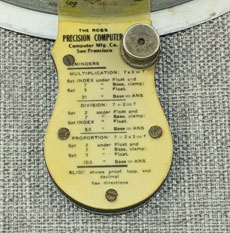 Left: Linear slide rule Right: Calculation examples on the handle Click a photo to enlarge |
|
|
|
Unfortunately, Louis Ross’s materials science
expertise was not up to his design prowess. Most Ross computers
surviving today suffer from heavy corrosion due to poor choices of
metals and finishing techniques. The problem is that the dial is
usually made of enamelled “pot metal” -- a cheap alloy known for its
inferior quality. The enamel, as well as the white coating on the
small slide rule, tend to pit, discolor or wear off. The unit seen
here is actually in good shape compared to most; I’ve seen others
where corrosion has rendered the scales entirely illegible. Rarely
the dial was made of stainless steel or brass, which have survived
in better shape, but such units are as rare as hens’ teeth (here
is one).UsageTo illustrate how the Ross Precision Computer works, here is a step by step multiplication example: Problem: calculate 1.841 x 3.25. Step 1: Rotate the dial to bring the “Index” arrow at its rim (which is located at the outer end of the spiral scale) under the hairline of the float cursor. Note that to rotate the dial you can grab it between thumb and forefinger, putting the latter through any of the three large cut-outs in the back of the disk. |
|
|
|
 Click photo to enlarge |
|
|
|
Step 2: rotate the base cursor by (moving the handle) to bring 1841 on the dial under its hairline. The labels at the right edge of the base cursor help identify the correct spiral turn. |
|
|
|
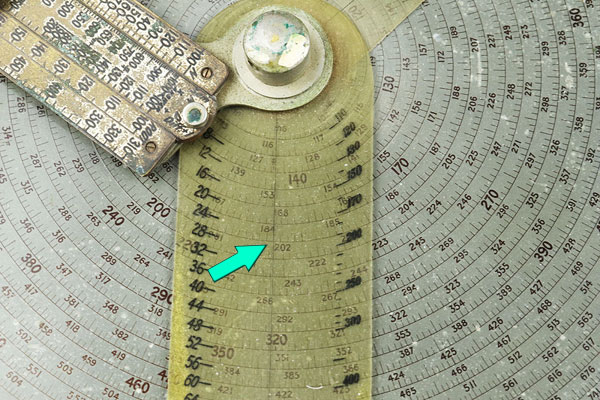 Click photo to enlarge |
|
|
|
Step 3: tighten the thumb-nut to lock the base cursor to
the back Disk. This fixes the angle between the two cursors, since
both are now connected to the Disk’s rim. Step 4: rotate the dial to bring 3.25 under the float cursor hairline. |
|
|
|
 Click photo to enlarge |
|
|
|
The answer is now under the hairline of the base cursor... but on which spiral turn? |
|
|
|
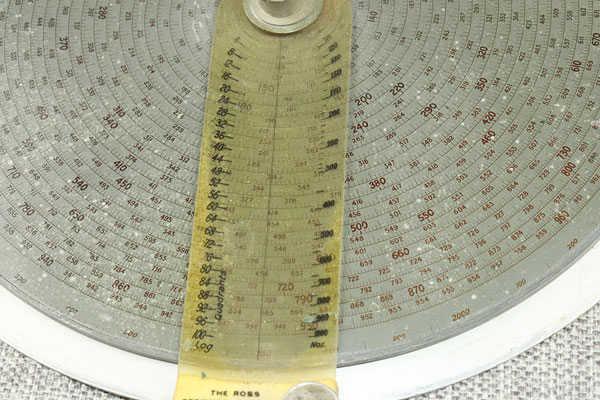 Click photo to enlarge |
|
|
|
Step 5: Use the small slide rule to calculate the approximate answer. You do this by moving its slide so the 1841 on the slide’s left scale is at 325 on the scale next to it on the rule’s stock. The result, a tad less than 600, is read on the stock opposite the arrow marked “Answer” on the slide’s bottom end (the arrow is wedged between 100 and 1000). There are two “Answer” arrows at the two ends of the slide, so one is always pointing at the scale on the stock). |
|
|
|
 Click photo to enlarge |
|
|
|
Step 6: Move the small slide rule to the right of the base cursor. The precise answer appears under the base cursor’s hairline in the spiral turn pointed at by the aforementioned “Answer” arrow: 59835. This is a good approximation of the exact value: 3.25 x 1.841 = 5.98325000. This isn’t quite the advertised five digits precision, but it’s pretty close. |
|
|
|
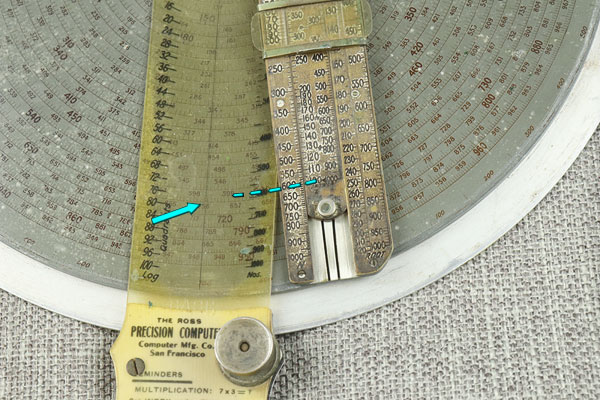 Click photo to enlarge |
|
|
|
If you followed this, you can see the
ingenuity of Ross’s invention. All spiral slide rules use the two
radial cursors, and give the answer under a hairline in one of them;
but they don’t tell you which spiral turn to read it on. The little
linear slide rule on the Ross device solves this problem by pointing
directly at the correct turn on the main spiral. Division is done in a manner similar to the above, with minor changes. Trigonometric functions of angles are presented along a five-turn spiral on the back of the device, as seen in the photos below. Five place logarithms are calculated using the “quadrant” scale at the left of the base cursor together with the scale on the outer rim of the dial. You can read the manual if you want the details. |
|
|
|

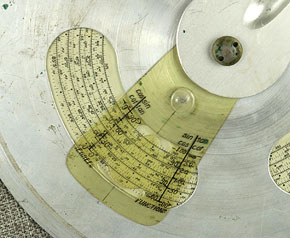 Click a photo to enlarge |
|
|
|
The inventor Louis Ross (pictured) was born in the
Ukraine in 1879 and immigrated with his family to the USA in 1892.
He attended Harvard College and graduated in civil engineering. In
addition, he taught Harvard courses in Applied Mechanics. He worked
as a surveyor for the United States Geological Survey and in 1907
opened a practice as surveyor and civil engineer in San Francisco.
In 1911 he was appointed a US Deputy Surveyor, and in parallel he
started to develop his slide rules. In the next few years he
introduced a number of models, and in 1915 he established the
Computer Manufacturing Company in downtown San Francisco, though it
seems likely that he was its only employee. The Precision Computer
shown here came out in the same year. Ross continued to make his
slide rules until about 1928, when he shut down his company and
returned full time to his original civil engineering and land
surveying profession. |
|
|
|
Exhibit provenance: eBay. More info: The manual of the Ross Precision Computer, and some additional content, is available courtesy of the Oughtred Society here. |
|
|
|
|
|
|
|
Home | HOC | Fractals | Miscellany | About | Contact Copyright © 2021 N. Zeldes. All rights reserved. |
|
